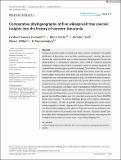Files in this item
Comparative phylogeography of five widespread tree species : insights into the history of western Amazonia
Item metadata
| dc.contributor.author | Honorio Coronado, Eurídice N. | |
| dc.contributor.author | Dexter, Kyle G. | |
| dc.contributor.author | Hart, Michelle L. | |
| dc.contributor.author | Phillips, Oliver L. | |
| dc.contributor.author | Pennington, R. Toby | |
| dc.date.accessioned | 2021-12-01T13:30:11Z | |
| dc.date.available | 2021-12-01T13:30:11Z | |
| dc.date.issued | 2019-06-27 | |
| dc.identifier | 276475061 | |
| dc.identifier | 0c0de599-4e07-49b8-9a90-29979b787182 | |
| dc.identifier | 85067394671 | |
| dc.identifier.citation | Honorio Coronado , E N , Dexter , K G , Hart , M L , Phillips , O L & Pennington , R T 2019 , ' Comparative phylogeography of five widespread tree species : insights into the history of western Amazonia ' , Ecology and Evolution , vol. 9 , no. 12 , pp. 7333-7345 . https://doi.org/10.1002/ece3.5306 | en |
| dc.identifier.issn | 2045-7758 | |
| dc.identifier.other | ORCID: /0000-0003-2314-590X/work/102330836 | |
| dc.identifier.uri | https://hdl.handle.net/10023/24455 | |
| dc.description | This work was funded by a FINCyT studentship to the lead author (Contract N° 074-2009-FINCyT-BDE), as well as by the School of Geography of the University of Leeds, Royal Botanic Garden Edinburgh, and the Davis Expedition Fund. OP was supported by NERC (grant numbers NE/S011811/1 and NE/F005806/1). | en |
| dc.description.abstract | Various historical processes have been put forth as drivers of patterns in the spatial distribution of Amazonian trees and their population genetic variation. We tested whether five widespread tree species show congruent phylogeographic breaks and similar patterns of demographic expansion, which could be related to proposed Pleistocene refugia or the presence of geological arches in western Amazonia. We sampled Otoba parvifolia/glycycarpa (Myristicaceae), Clarisia biflora, Poulsenia armata, Ficus insipida (all Moraceae), and Jacaratia digitata (Caricaceae) across the western Amazon Basin. Plastid DNA (trnH–psbA; 674 individuals from 34 populations) and nuclear ribosomal internal transcribed spacers (ITS; 214 individuals from 30 populations) were sequenced to assess genetic diversity, genetic differentiation, population genetic structure, and demographic patterns. Overall genetic diversity for both markers varied among species, with higher values in populations of shade-tolerant species than in pioneer species. Spatial analysis of molecular variance (SAMOVA) identified three genetically differentiated groups for the plastid marker for each species, but the areas of genetic differentiation were not concordant among species. Fewer SAMOVA groups were found for ITS, with no detectable genetic differentiation among populations in pioneers. The lack of spatially congruent phylogeographic breaks across species suggests no common biogeographic history of these Amazonian tree species. The idiosyncratic phylogeographic patterns of species could be due instead to species-specific responses to geological and climatic changes. Population genetic patterns were similar among species with similar biological features, indicating that the ecological characteristics of species impact large-scale phylogeography. | |
| dc.format.extent | 13 | |
| dc.format.extent | 1446046 | |
| dc.language.iso | eng | |
| dc.relation.ispartof | Ecology and Evolution | en |
| dc.subject | Amazon biogeography | en |
| dc.subject | Genetic diversity | en |
| dc.subject | Late successional species | en |
| dc.subject | Phylogeography | en |
| dc.subject | Pioneer species | en |
| dc.subject | Ecology, Evolution, Behavior and Systematics | en |
| dc.subject | Ecology | en |
| dc.subject | Nature and Landscape Conservation | en |
| dc.subject | DAS | en |
| dc.title | Comparative phylogeography of five widespread tree species : insights into the history of western Amazonia | en |
| dc.type | Journal article | en |
| dc.contributor.institution | University of St Andrews. School of Geography & Sustainable Development | en |
| dc.identifier.doi | 10.1002/ece3.5306 | |
| dc.description.status | Peer reviewed | en |
This item appears in the following Collection(s)
Items in the St Andrews Research Repository are protected by copyright, with all rights reserved, unless otherwise indicated.

